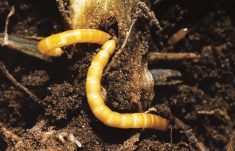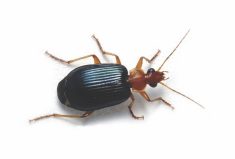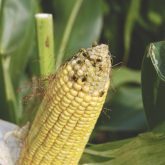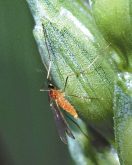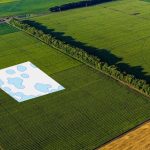With snow still on the ground as this article is written, it’s difficult to predict how conditions may change over the next few weeks as farmers approach seeding. That said, lower-than-average precipitation across the Prairies over the winter indicates it will take some excessive spring moisture to significantly change the dry conditions that seem likely going into a new growing season.
Based on what we know so far, Country Guide asked provincial insect specialists across the Prairies for their predictions about potential pests farmers could see in their fields this year.
Manitoba
Insects that should be a high priority for Manitoba farmers to monitor in 2018 include flea beetles and bertha armyworm in canola as well as cutworms and alfalfa weevil, says Manitoba Agriculture’s provincial entomologist John Gavloski. “These are all insects that were problems last year, and can overwinter well in Manitoba.”
Cutworms and bertha armyworm have better winter survival when there is good snow cover to insulate them from the cold temperatures. Many areas of Manitoba had little snow cover and cold temperatures over the winter, which may lower the risk for these pests.

Flea beetles and alfalfa weevil tend to overwinter in areas when snowfall accumulates, so they would be less affected by the drier, cold conditions in January and February. Gavloski advises farmers to monitor populations of flea beetles, cutworms and alfalfa weevil in May and June, and to look for bertha armyworm in July and August. Manitoba Agriculture monitors populations of adult bertha armyworm in June and July to try to predict areas of greater risk, so it’s important that producers check provincial insect forecast maps and other information on the Manitoba Agriculture site, which is constantly updated.
Other insects that are less predictable but that should also be monitored include diamondback moth (which primarily affects canola and mustard), soybean aphids and aphids on cereals. These either do not overwinter in Manitoba, or survive only in low numbers. “What we get depends on what moves in from the south, which can be unpredictable,” says Gavloski.
Read Also

Producers aren’t panicking over tariffs and trade threats
The influence of tariff and trade uncertainity on farm business decisions.
2017 was a bad year for soybean aphids, but Manitoba has not yet had two consecutive years with high levels. “It’s not impossible for this to happen, but in the past, outbreak years of soybean aphid have been followed by at least one year of much lower levels,” says Gavloski. “Producers should scout for soybean aphids in July and August.”
Diamondback moth was an issue for some Manitoba canola growers last year, partly because of dry conditions, which meant they were feeding earlier than normal and on pods, rather than leaves, which compounded the problem. Manitoba Agriculture monitors for the arrival of diamondback moth using pheromone-baited traps, so again producers need to check for updated information about population numbers and areas of predicted concern.
Grasshoppers, as in 2017, seem to pose a low risk for 2018, based on counts done last August, but a dry late spring and summer could increase the risk. Manitoba Agriculture also has a grasshopper forecast online, as well as detailed insect information and scouting guides.
Saskatchewan
After a hot, dry year in 2017, and the potential for similar conditions this year in Saskatchewan, there is potential for some heavy flea beetle pressure in canola. As well, entomologists in the province have been surprised by bertha armyworm in canola over the last couple of years.
“We should be on the low end of what is a more cyclical insect, but we’ve had two years in a row where in the central part of the province, around the Watrous area, there has been some spraying reported,” says James Tansey, Saskatchewan’s new provincial insect specialist. “We will continue to monitor for bertha armyworm this year in real time, and that information will be posted on the website.”
Infestations of diamondback moth in canola vary from year to year depending on the wind currents that bring them in from the United States, and although last year the pest wasn’t a major issue in Saskatchewan, provincial monitoring using pheromone traps and assessing wind trajectories will continue as usual.
Cabbage seedpod weevil continues to move mostly eastward through Saskatchewan and is not expected to stop. Producers growing canola or brown or oriental mustard should scout when crops start to flower.
Although difficult to predict, there is always potential for issues with different cutworm species because they each have different moisture and heat preferences. “It’s probably best for producers to keep an eye out for cutworms,” says Tansey.
Generally, producers should not expect much wheat midge pressure in cereals. The overwintering wheat midge cocoon requires more than 25 mm of precipitation prior to the end of May in order to move into the pupal stage for emergence. “If you don’t get that, you see reduced or erratic emergence, which is what we saw last year because of the dry spring conditions,” says Tansey. “Populations are based on cocoons in the soil, and rarely have we seen a wheat midge forecast this low. That said, we’re not monitoring every field, so it’s good for growers to still be keeping an eye out for wheat midge in their own fields if a midge-tolerant wheat variety is not grown.”
As in most areas of the Prairies, the grasshopper risk forecast is low this year, but dry conditions do favour grasshoppers, so it’s important for producers to monitor when the hatch starts, usually around early June, to get an idea of their own risk, particularly if they are growing lentils, which are higher risk.

“The economic threshold for lentils is only two per square metre, and it doesn’t take much to get there,” says Tansey. “In lentils the risk is primarily once it starts flowering. Grasshoppers are not prone to the foliage, but they do like the flowers and especially the developing pods.”
Still with pulse crops, the 2017 pea leaf weevil survey indicated that the pea leaf weevil is present at varying levels throughout most of southern Saskatchewan including eastern parts, but movement north has been restricted. “It did increase a bit last year, so risk would be proportionate to the populations,” says Tansey.
Because a seed treatment appears to be the best, most consistent method to control pea leaf weevil in peas and fababeans, producers should consult forecast maps for early regional pressures.
“Research out of Agriculture & Agri-Food Canada’s Lethbridge Research and Development Centre has not shown consistent results with a foliar spray,” says Tansey. “The economic threshold for pea leaf weevil is one to three plants or roughly 30 per cent with clam (most recently emerged) leaf damage, but it doesn’t always show consistent yield, whereas the seed treatment is more reliable.”
Alberta
The biggest insect story for Alberta last year was diamondback moth in canola, but that has no bearing on what will happen this year, again because it will depend on how many adult moths are carried up from the United States on wind currents in the spring.
Last year’s field surveys show that cabbage seedpod weevil in canola backed off a little in 2017, but it’s a perennial issue in southern Alberta and likely will be again.
Forecast maps are showing there may be some issues with wheat midge east of Edmonton, where it’s already been a problem for a couple of years now.
Staying with cereals, wheat stem sawfly is a minor issue going into 2018, except for some areas in southern Alberta around Willow Creek, Vulcan and Lethbridge counties, where it seems to be increasing. “It’s not likely to affect major acreages, but I think farmers in southern Alberta need to be aware that wheat stem sawfly could be present in those areas,” says Scott Meers, Alberta’s insect management specialist.

Pea leaf weevil is probably one of the other biggest changes over the last few years, as it has expanded up the Highway No. 2 corridor into the Edmonton area. “Pea leaf weevil has been a perennial issue south of Highway No. 1 for quite a number of years now, but in 2014, it began expanding up the Highway No. 2 corridor,” says Meers. “It’s not entirely clear why, although we did expect it to become an issue in the Red Deer and Lacombe areas based on climate models done by Owen Olfert’s group out of Saskatoon. It’s an invasive pest that continues to expand its area.”
Bertha armyworm numbers have been low for the past three years in Alberta, and typically outbreaks are on a five- or six-year cycle. Agrologists and researchers will be watching it closely, and although they don’t expect any big problems with it this year, they are alert for signs of an increase in population that could signal another outbreak in coming years. “We trap for bertha armyworm in June through July to forecast what might happen in early August,” says Meers.
Alberta is working on revamping its forecast model for grasshoppers, which hasn’t been entirely effective in some areas of the province, especially north-central Alberta and the Peace country. “The forecast says that we will have problems but if we go back over the last 10 years, whenever we forecast a big problem, it hasn’t happened, so we’re not entirely confident with our models and are working with AAFC in Saskatoon to improve the forecast models,” says Meers.
On its website, Alberta Agriculture has live reporting maps on cutworms, diamondback moths, bertha armyworms, cabbage seed pod weevil and wheat midge that change hourly as producers and agrologists report numbers from the field in season. It also sends out regular updates via Twitter and also does a weekly radio talk every Thursday about the current situation, which is also available as a podcast on the website.
Prairie Pest Monitoring Network
A good source of up-to-date information and forecasts on pests is the weekly blog from the Prairie Pest Monitoring Network (PPMN) which has been developing monitoring protocols and co-ordinating the monitoring of field crop insect populations for more than 20 years.
The PPMN is comprised of researchers and entomologists across the Prairies who conduct research and actively monitor insect populations to help support producers’ crop protection decisions.
The PPMN has weekly updates and simulation forecast models for all the major field crop pests as well as weather, temperature and precipitation synopses, growing degree day maps, scouting tips, economic thresholds and in-season crop reports across Alberta, Saskatchewan and Manitoba.
The importance of scouting
Although there are plenty of resources such as the PPMN and provincial websites which give a good idea of what’s happening on a regional basis, when things are starting to heat up in a specific area, it’s vital for producers to get out into their own fields and scout for issues.
“There is no replacement for footprints in the field,” says Meers. “The only way to know what’s happening in your field is to be in your field. We often see insect populations that are above threshold in one field and then right across the road the neighbour is not having an issue.”
Resources
- Manitoba Agriculture: Grasshopper Forecast
- Manitoba Agriculture: Insect information and scouting guides
- Saskatchewan Ministry of Agriculture Insects — scouting information and forecast maps
- Prairie Pest Monitoring Network (blog)
- Alberta Agriculture Insect Pest Monitoring Network
This article first appeared on AGCanada.com.




